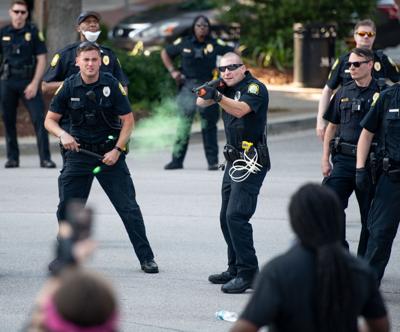It was either an unimaginably bad coincidence or else a classic case of a cop who didn’t need to be a cop: someone who’s too quick to escalate, too anxious to perceive a mortal threat, too unwilling to look for ways to calm a situation. Someone who as a result endangers the community and all of his fellow police officers who are struggling to keep our communities safe.
As The Post and Courier’s Joseph Cranney reports, Columbia police officer Sean Rollins shot a driver in the back of the head after a 2019 traffic stop turned into a scuffle inside the vehicle. Then, after he was cleared, he had eight more violent encounters in 2020 — all but one with people who were unarmed and who were suspected of relatively minor offenses ranging from “aggressive begging” to assault — over the course of five months.
It’s not precisely the same as lightning striking twice in the same place, but in a city where police officers use force an average of less than once a year, the frequency of those encounters should have raised alarms — and should have raised the bar with each subsequent case.
Instead, over and over, internal investigators looked at the discrete circumstances of each encounter and concluded that the officer’s actions were justified: when he used a jawline grip to subdue a handcuffed woman, who hit her head and passed out; when he tackled and bloodied a 55-year-old woman in her own living room; when he tackled a man accused of snatching cigarettes; when he tackled and used his stun gun on a man standing in the middle of a road.
It was only after Mr. Cranney reviewed body-cam footage and more than 180 pages of police reports, and interviewed police, experts and members of the public and told the story of each of those encounters, that Mr. Rollins was fired.
Which means it’s also a classic example of the importance of real journalism, which gathers up troves of government documents that aren’t readily available to the public, and then spends the time going through them and writing in an honest way that gives all sides the ability to have their say — and is so powerful because it does all that rather than just going straight to condemnation.
We’re glad that Columbia Police Chief Skip Holbrook finally decided to let Mr. Rollins go, but we’re disturbed that he didn’t act until the newspaper got involved. We’re even more disturbed by the certain knowledge that there are other cases — perhaps not so dramatic but no less clear — that don’t get resolved because they don’t receive this level of scrutiny.
Police in South Carolina and across the nation are far too eager to close ranks, to act as though the fact that an officer doesn’t break the law or even violate policy means he didn’t do anything wrong and doesn’t need to be fired — even though the overwhelming number of people who don’t have the authority to use lethal force on the job get fired every day just because their employers realize they aren’t cut out for the job. Our police are too unwilling to acknowledge that some people just don’t have the temperament to wear a badge and carry a gun — and that allowing them to do so gives the public reasons to distrust the police, and makes the job of police officer so much more dangerous for all those dedicated officers who do have the temperament for the job.
There are a lot of things the S.C. Legislature could and should do to address this problem — from providing better training in de-escalating potentially violent encounters and making police body-cam video more readily available to the public to placing state limits on the use of force and requiring outside investigations when police kill or injure people.
But unlike some states, South Carolina isn’t handcuffed by police unions that can insist on ridiculous protections to ensure that cops are never held accountable unless they’re convicted of a crime. Police chiefs and especially sheriffs across our state have the power to weed out officers who just don’t belong.
They don’t have to wait until an officer is convicted of a crime. They don’t have to wait until an officer is charged with a crime. They don’t have to wait, after a critical event, until a criminal investigation has run its course. They don’t even have to wait for a specific case that demands a criminal investigation.
They can simply decide that they want officers and deputies who remember that their primary job is to be a partner with and protector of the public. They can simply decide that even though an officer isn’t committing a crime or violating internal procedures, he’s just getting into violent encounters too often, and that indicates that he doesn’t have the temperament for the job.
If they have policies in place that make this too difficult, then they need to change those policies. And then they need to start treating their employees the way nearly every other employer does, by requiring them to live up to a standard that’s a lot higher than simply not breaking the law.













